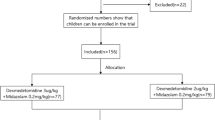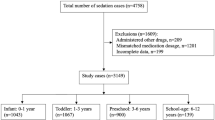Abstract
Children with autism often need sedation for diagnostic procedures and they are often difficult to sedate. This prospective randomized double-blind control trial evaluates the efficacy and safety using intranasal dexmedetomidine with and without buccal midazolam for sedation in children with autism undergoing computerized tomography and/or auditory brainstem response test. The primary outcome is the proportion of children attaining satisfactory sedation. One hundred and thirty-six children received intranasal dexmedetomidine and 139 received intranasal dexmedetomidine with buccal midazolam for sedation. Combination of intranasal dexmedetomidine and buccal midazolam was associated with higher sedation success when compared to intranasal dexmedetomidine. Since intranasal and buccal sedatives required little cooperation this could be especially useful technique for children with autism or other behavioral conditions.


Similar content being viewed by others
References
Bailey, C. (2016). Sedation in children—is it time to change our practice? Anaesthesia, 71(5), 501–505.
Ebert, T. J., Hall, J. E., Barney, J. A., Uhrich, T. D., & Colinco, M. D. (2000). The effects of increasing plasma concentrations of dexmedetomidine in humans. Anesthesiology, 93(2), 382–394.
Hall, J. E., Uhrich, T. D., Barney, J. A., Arain, S. R., & Ebert, T. J. (2000). Sedative, amnestic, and analgesic properties of small-dose dexmedetomidine infusions. Anesthesia & Analgesia, 90(3), 699–705.
Hartman, M. E., & Cheiftz, I. M. (2011). Pediatric emergencies and resuscitation. In R. M. Kliegman, B. F. Stanton, J. W. St. Geme, N. F. Schor, & R. E. Behrman (Eds.), Nelson textbook of pediatrics (19th ed., pp. 279–296). Philadelphia: Elsevier.
Li, B. L., Ni, J., Huang, J. X., Zhang, N., Song, X. R., & Yuen, V. M. (2015). Intranasal dexmedetomidine for sedation in children undergoing transthoracic echocardiography study-a prospective observational study. Paediatric Anaesthesia, 25(9), 891–896. https://doi.org/10.1111/pan.12687.
Li, B. L., Yuen, V. M., Song, X. R., Ye, J., Ni, J., Huang, J. X., et al. (2014). Intranasal dexmedetomidine following failed chloral hydrate sedation in children. Anaesthesia, 69(3), 240–244. https://doi.org/10.1111/anae.12533.
Li, B. L., Yuen, V. M., Zhou, J. L., Zhang, N., Huang, J. X., Tian, H., et al. (2018). A randomized controlled trial of oral chloral hydrate vs intranasal dexmedetomidine plus buccal midazolam for auditory brainstem response testing in children. Paediatric Anaesthesia, 28(11), 1022–1028. https://doi.org/10.1111/pan.13498.
Li, B. L., Zhang, N., Huang, J. X., Qiu, Q. Q., Tian, H., Ni, J., … Irwin, M. G. (2016). A comparison of intranasal dexmedetomidine for sedation in children administered either by atomiser or by drops. Anaesthesia, 71(5), 522–528. https://doi.org/10.1111/anae.13407.
Lubisch, N., Roskos, R., & Berkenbosch, J. W. (2009). Dexmedetomidine for procedural sedation in children with autism and other behavior disorders. Pediatric Neurology, 41(2), 88–94. https://doi.org/10.1016/j.pediatrneurol.2009.02.006.
McConachie, H., & Diggle, T. (2007). Parent implemented early intervention for young children with autism spectrum disorder: a systematic review. Journal of Evaluation in Clinical Practice, 13(1), 120–129. https://doi.org/10.1111/j.1365-2753.2006.00674.x.
Mehta, U. C., Patel, I., & Castello, F. V. (2004). EEG sedation for children with autism. Journal of Developmental and Behavioral Pediatrics, 25(2), 102–104.
Moore, V., & Goodson, S. (2003). How well does early diagnosis of autism stand the test of time? Follow-up study of children assessed for autism at age 2 and development of an early diagnostic service. Autism, 7(1), 47–63.
Pasin, L., Febres, D., Testa, V., Frati, E., Borghi, G., Landoni, G., et al. (2015). Dexmedetomidine vs midazolam as preanesthetic medication in children: a meta-analysis of randomized controlled trials. Paediatric Anaesthesia, 25(5), 468–476. https://doi.org/10.1111/pan.12587.
Rapin, I., & Tuchman, R. F. (2008). Autism: definition, neurobiology, screening, diagnosis. Pediatric Clinics of North America, 55(5), 1129–1146. https://doi.org/10.1016/j.pcl.2008.07.005.
Ray, T., & Tobias, J. D. (2008). Dexmedetomidine for sedation during electroencephalographic analysis in children with autism, pervasive developmental disorders, and seizure disorders. Journal of Clinical Anesthesia, 20(5), 364–368. https://doi.org/10.1016/j.jclinane.2008.03.004.
Reynolds, J., Rogers, A., Capehart, S., Manyang, P., & Watcha, M. F. (2016). Retrospective comparison of intranasal dexmedetomidine and oral chloral hydrate for sedated auditory brainstem response exams. Hospital Pediatrics, 6(3), 166–171. https://doi.org/10.1542/hpeds.2015-0152.
Ross, A. K., Hazlett, H. C., Garrett, N. T., Wilkerson, C., & Piven, J. (2005). Moderate sedation for MRI in young children with autism. Pediatric Radiology, 35(9), 867–871. https://doi.org/10.1007/s00247-005-1499-2.
Smith, T., Groen, A. D., & Wynn, J. W. (2000). Randomized trial of intensive early intervention for children with pervasive developmental disorder. American Journal of Mental Retardation, 105(4), 269–285. https://doi.org/10.1352/0895-8017(2000)105%3c0269:RTOIEI%3e2.0.CO;2.
Song, Y., Wang, Y., Thakur, R., Meidan, V. M., & Michniak, B. (2004). Mucosal drug delivery: Membranes, methodologies, and applications. Critical Reviews in Therapeutic Drug Carrier Systems, 21(3), 195–256.
Sulton, C., McCracken, C., Simon, H. K., Hebbar, K., Reynolds, J., Cravero, J., … Kamat, P. (2016). Pediatric procedural sedation using dexmedetomidine: A report from the Pediatric Sedation Research Consortium. Hospital Pediatric, 6(9), 536–544. https://doi.org/10.1542/hpeds.2015-0280.
Yuen, V., Li, B., Cheuk, D., Leung, M., Hui, T., Wong, I., … Irwin, M. (2017). A randomised controlled trial of oral chloral hydrate vs. intranasal dexmedetomidine before computerised tomography in children. Anaesthesia, 72(10), 1191-1195.
Yuen, V. M., Hui, T. W., Irwin, M. G., Yao, T. J., Chan, L., Wong, G. L., … Shariffuddin, II. (2012). A randomised comparison of two intranasal dexmedetomidine doses for premedication in children. Anaesthesia, 67(11), 1210–1216. https://doi.org/10.1111/j.1365-2044.2012.07309.x.
Yuen, V. M., Hui, T. W., Irwin, M. G., Yao, T. J., Wong, G. L., & Yuen, M. K. (2010). Optimal timing for the administration of intranasal dexmedetomidine for premedication in children. Anaesthesia, 65(9), 922–929. https://doi.org/10.1111/j.1365-2044.2010.06453.x.
Yuen, V. M., Hui, T. W., Irwin, M. G., & Yuen, M. K. (2008). A comparison of intranasal dexmedetomidine and oral midazolam for premedication in pediatric anesthesia: A double-blinded randomized controlled trial. Anesthesia and Analgesia, 106(6), 1715–1721. https://doi.org/10.1213/ane.0b013e31816c8929.
Yuen, V. M., Irwin, M. G., Hui, T. W., Yuen, M. K., & Lee, L. H. (2007). A double-blind, crossover assessment of the sedative and analgesic effects of intranasal dexmedetomidine. Anesthesia and Analgesia, 105(2), 374–380. https://doi.org/10.1213/01.ane.0000269488.06546.7c.
Acknowledgments
We gratefully acknowledge the assistance of Ms Jeff SF Man, Department of Anaesthesiology, University of Hong Kong, for statistical analysis. BLL and VMY conceived of the study, participated in its design, coordination, interpretation of the data and drafted and revised the manuscript. BLL, NZ, HHZ, JXH, SYY helped gathering data, conceptualizing and drafting the initial manuscript, and approved the final manuscript as submitted. JMM and XRS participated in the design and carried out the initial analyses, reviewed and revised the manuscript, and approved the final manuscript as submitted. All authors critically reviewed and approved the final manuscript as submitted.
Funding
This study is funded by Guangzhou Health and Family Planning Commission Program (No. 20182A011005), Guangzhou, China and Guangzhou Women and Children’s Medical Center/Guangzhou Institute of Pediatrics (No. Pre-NSFC- 2018-015), Guangzhou, China.
Author information
Authors and Affiliations
Corresponding author
Ethics declarations
Conflict of interest
The authors have no potential conflict of interest to disclose.
Additional information
Publisher's Note
Springer Nature remains neutral with regard to jurisdictional claims in published maps and institutional affiliations.
Bi Lian Li and Vivian Man-ying Yuen contributed equally to this study.
Rights and permissions
About this article
Cite this article
Li, B.L., Yuen, V.My., Zhang, N. et al. A Comparison of Intranasal Dexmedetomidine and Dexmedetomidine Plus Buccal Midazolam for Non-painful Procedural Sedation in Children with Autism. J Autism Dev Disord 49, 3798–3806 (2019). https://doi.org/10.1007/s10803-019-04095-w
Published:
Issue Date:
DOI: https://doi.org/10.1007/s10803-019-04095-w




